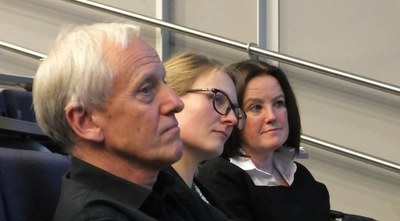New barometer measures the level of collective decision making in Norway
People’s perceived level of influence over their own work situation has plummeted in Norway. In seven years the number of people saying they have a lot of influence has fallen from 89 percent to 77 percent. Imported leadership models get the blame.
“A change of 12 percentage point in seven years is a lot,” underlined researcher Eivind Falkum as he presented the results from the survey together with his two colleagues from the Work Research Institute in Oslo, Mari Holm Ingelsrud and Bitten Nordrik (below).

The plan is to carry out the collective decision making barometre every year, sometimes supported by independent surveys carried out by the six trade unions which have financed the barometre. This year’s survey posed the same questions as the ones used in 2009 for a major survey on the state of the corporate democracy, carried out by the research foundation Fafo.
The barometer is based on answers from more than 3,000 people. The six trade unions represent occupations like medical doctors, researchers, police and oil industry workers. The barometer uses 19 questions which are then gathered into three indexes which measure how much influence the workers feel they have on their own work situation, the way work is organised and the way the company is run.
The biggest differences are found in how employees view their own work situation:
If you add up the ones answering four and five on a scale from one to five for how much they feel they are able to influence their own work situation, the group has shrunk considerably with 12 percentage points. The fall is not so large for the other two indexes, at three percentage points.
Different occupational groups enjoy different levels of influence when it comes to how work is organised, but the trades are defined differently compared to 2009, which makes it impossible to look at how things have developed over time in that regard.
While only 18 percent of those working in the healthcare sector feel they have influence over how work is organised, a full 63 percent of researchers feel the same.
“Researchers do pretty well, but we too feel that employers don’t always know what the rules on collective decision making actually entail,” said Petter Aaslestad from the Norwegian Association of Researchers when the six trade unions commented on the barometre.
Unn Alma Skatvold from the Norwegian Police Federation felt working life was becoming increasingly authoritarian:
“We are worried that is the way things are going. Officially everything is done according to the book, but in practice things are still moving in an authoritarian direction.”
Jonny Simmenes from the Norwegian Engineers and Managers Association was the most critical:
“The Norwegian leadership model is under threat. Our members work in the industry and are leaders with personnel responsibilities. They feel they have less influence today. Corporate democracy has never been under greater threat than it is today.”
Several of the six trade union representatives pointed out that the collective decision making barometre supported what they had experienced themselves in conversation with their members – that collective decision making is becoming less common. This issue has also been the cause of several labour conflicts in the public sector in Norway.
“Corporate democracy and democracy in the workplace is weakest in the public sector, both when it comes to the individual’s opportunity to take part and for employees and their organisations to be part of a collective decision making process. This puts disagreements and recent conflicts on working hours in the health sector in a new light,” write the three researchers from the Work Research Institute.
Earlier this year Norwegian doctors went on strike over who should be responsible for the way hospitals were run.
- Less collective decision making
-
Three trade unions organising different occupational groups, but all see a weakening of collective decision making. Left to right: Christian Grimsgaard, the Norwegian Medical Association, Hilde-Marit Rysst, SAFE, which organises oil sector workers and Unn Alma Skatvold, the Norwegian Police Federation
 Follow us on Facebook
Follow us on Facebook
